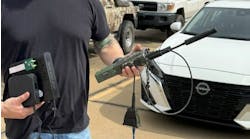Testing the Right Way in a Bonded DSL Environment
A simple way for service providers to increase revenues while keeping costs low is to look at the recent advances in DSL, namely the approach of bonding. DSL bonding, as defined by the ITU-T G.998.x standards, takes 2 pairs of copper wire and ultimately provides the service provider with the possibility of increasing data rates to existing subscribers or attracting new subscribers. In the end, it’s the services, content, and speed that subscribers are pushing for from providers. Thanks to bonding, providers can now deliver on their promises — with minimal investment.
Traditionally, DSL technicians and engineers alike have been using test sets that connect up to a single copper pair for physical-layer verification of performance, by collecting metrics such as actual data rates, SNR margins, and attenuation. These performance metrics are evaluated by the test set and provide clear pass/fail indication to the user that all is well (or not, if a failure occurs). Likewise, once the physical layer has been validated, higher-layer testing such as verification of IPTV performance or verification of Internet connectivity (i.e., Web browsing) can take place over this single copper pair.
With ADSL2+ and VDSL2 bonding now available, service providers can overcome the inherent flaws of traditional single-pair DSL and IPTV performance verification in a bonded environment, and turn to a bonded DSL test solution to properly validate the physical attributes as well as the services that run over this bonded circuit.
Getting Comfy With DSL Layer Testing
The configuration of the DSLAM to support bonding is such that a "group" is defined. This bonded group defines such parameters as the desired bonded data rate and the DSL ports to use within the group. It should be noted that the ports — and by extension the copper pairs — do not need to be adjacent to each other. In this case, testing single pairs may yield sync; however testing only via a bonded solution will indicate whether the pairs under test are connected to the same pair group or not.
In general, the system (DSLAM, modem) uses the group information as part of the training sequence and evaluates each pair’s suitability during the training sequence. The bonding standards allow the bonding of pairs whose rates differ by a ratio of 4:1 (maximum deviation). In this regard, only a bonded test solution can simplify the understanding of the group and its allocation of data rate on each pair (and does not require a calculator).
Typically, pairs designated for bonding are adjacent to each other, pending any sort of copper fault that may exist on one or the other. Due to this close proximity, crosstalk is another element that can be seen only when conducting bonded DSL testing. When both pairs to the subscriber are turned up, crosstalk between pairs is generated and the impact can be seen on the bonded test set. If testing one pair at a time, the full impact of crosstalk is not seen, resulting in false positive deployments.
Lastly, concerning the DSL layer, when the DSLAM is set to bonding, and designates 2 pairs as a group, the training sequence requires the necessary bonded messaging to occur. If conducting single-pair testing in a designated bonded environment, a maintenance profile needs to be loaded into the DSLAM to remove the group, thus creating single pairs. This venture is time-consuming, as the technician in the field needs to rely on the prompt response from the central office staff to not only load the maintenance profile into the DSLAM, but also to remember what was the original bonded profile/VLAN configuration/bonded timer, to reactivate the subscriber once the single-pair testing is completed.
Getting REALLY Tight With Bonding
Single-pair testing in a bonded environment does not allow the technician to realize the proper throughput speeds. If the objective is to offer 3 high-definition (HD) IPTV streams (total of ~ 24 Mbit/s), 3 standard-definition (SD) IPTV streams (total of ~ 6 Mbit/s), and about 5 Mbit/s of high-speed Internet, the grand total of 35 Mbit/s can be achieved through single-pair VDSL2 and bonded ADS2+ — but not through single-pair ADSL2+. In this situation, services cannot be fully assessed when doing single-pair testing in a bonded environment. Furthermore, single-pair testing may force packet loss, but from the technician’s perspective, it is not clear whether the packet loss results from a physical-layer or DSL-layer issue or from the fact that the single-pair testing is conducted in a bonded environment.
To sum up, utilizing a single-pair test set in a bonded environment will result in:
• False positive data rate performance of pairs.
• Testing pairs not belonging to the same group, leading the technician toward erroneous diagnostics.
• DSLAM dropping connection after a short period, resulting in a time-consuming maintenance load to be loaded/removed from the circuit.
• Inability to properly determine the throughput and quality of the services.
• Possible incorrect manual calculation of actual and attainable bonded group rate.
Therefore, testing the right way in a bonded DSL environment is the only way to ensure proper delivery of service to the end subscriber.
Chris Dunford is Product Line Manager, Access Business Unit, Wireline Division, EXFO and has 11 years of experience in this position. He has responsibility for handheld products focusing on physical layer FTTN and advanced Triple Play services testing. Mr. Dunford is a member of the Broadband Forum (www.broadband-forum.org). For more information about EXFO, visit www.exfo.com.




